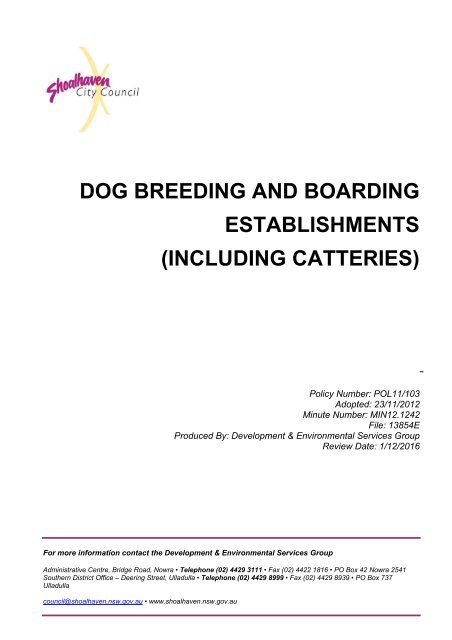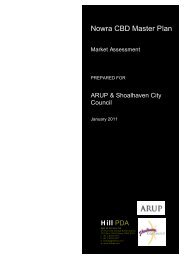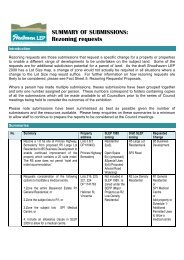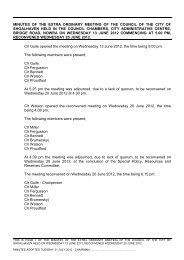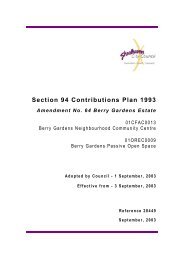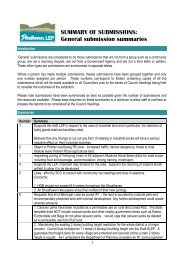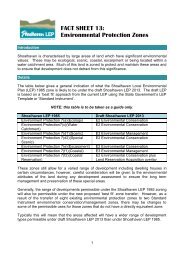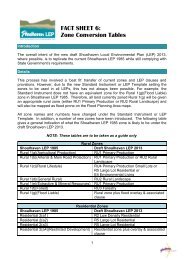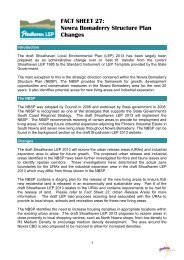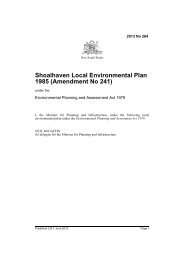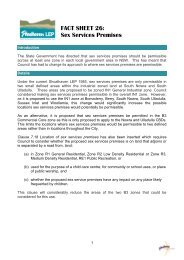Dog Breeding and Boarding (Including Catteries) Establishments
Dog Breeding and Boarding (Including Catteries) Establishments
Dog Breeding and Boarding (Including Catteries) Establishments
You also want an ePaper? Increase the reach of your titles
YUMPU automatically turns print PDFs into web optimized ePapers that Google loves.
CONTENTS1. PURPOSE .....................................................................................................12. AIMS..............................................................................................................13. WHERE DOES THIS POLICY APPLY..........................................................14. DEFINITION ..................................................................................................15. APPLICATION FOR DEVELOPMENT CONSENT.......................................26. CONTROLS...................................................................................................26.1. Minimum Allotment Size..............................................................................................36.2. Maximum number of dogs <strong>and</strong> cats (boarding) ........................................................36.3. Maximum number of dogs <strong>and</strong> cats (breeding) ........................................................46.4. Separation distances <strong>and</strong> screening..........................................................................46.5. Design material <strong>and</strong> animal welfare ...........................................................................56.6. Noise control ................................................................................................................56.7. Hygiene <strong>and</strong> waste management................................................................................66.8. Access, Crossovers <strong>and</strong> Parking Areas ....................................................................66.9. Advertising signs .........................................................................................................76.10. Additional requirements for the Calymea Street/Albatross Road area ...............87. IMPLEMENTATION ......................................................................................98. REVIEW.......................................................................................................109. APPLICATION OF ESD PRINCIPLES .......................................................10Page i
1. PURPOSEThe purpose of the policy is to provide guidance for persons establishing <strong>and</strong> operatingpremises for dog breeding <strong>and</strong> boarding establishments (including catteries) within the City,to protect resident amenity <strong>and</strong> ensure good animal keeping practices.The policy supercedes Council’s policy on “Keeping of <strong>Dog</strong>s in the Calymea Street/ AlbatrossRoad Area (Nowra) <strong>and</strong> Interim Guidelines for the Assessment of Development Applicationsthroughout the City of Shoalhaven”.2. AIMSTo ensure that dog breeding <strong>and</strong> boarding establishments (including catteries) are sited <strong>and</strong>designed to:prevent the amenity of the surrounding areas from being adversely affected by theemission of noise <strong>and</strong> odour from the operations of the establishment;prevent the discharge <strong>and</strong> waste beyond the buildings or areas in which the animalsare kept;ensure the animals are kept in conditions that meet animal welfare st<strong>and</strong>ards; <strong>and</strong>provide guidance for good management practices for dog breeding <strong>and</strong> dog <strong>and</strong> catboarding establishments that are consistent with Animal Welfare Codes administeredby the Department of Industry <strong>and</strong> Investment <strong>and</strong> adopted by <strong>Dog</strong>s NSW <strong>and</strong> theGreyhound Racing Board.3. WHERE DOES THIS POLICY APPLYThe policy applies to l<strong>and</strong> where animal boarding or training establishments are permittedwith consent under the Shoalhaven Local Environmental Plan 2014 (SLEP 2014) asapplicable.The policy applies to premises where: there are 4 or more dogs kept, <strong>and</strong> there is provisions for boarding of dogs <strong>and</strong>/or cats; or more than one litter (dog or cat) at a time is kept.4. DEFINITION(This is the draft SLEP 2009 definition; if SLEP 2014 applies the definition is slightly different)Animal boarding or training establishment means a building or place used for thebreeding, boarding, training, keeping or caring of animals for commercial purposes (otherthan for the agistment of horses) <strong>and</strong> includes any associated riding school or ancillaryveterinary hospital.Page 1
SLEP 2014 definition is:Animal boarding establishment means a building or place where cats or dogs are bred,trained, accommodated or nurtured for gain or reward.Hobby Breeder means a person who keeps <strong>and</strong>/or trains two (2) <strong>and</strong> not more than four (4)dogs <strong>and</strong> is eligible to register with the <strong>Dog</strong>s NSW <strong>and</strong> complies with the Animal WelfareCode of Conduct.Professional Breeder means a person who keeps, breeds <strong>and</strong>/or trains 5 or more dogs <strong>and</strong>is eligible to register with <strong>Dog</strong>s NSW <strong>and</strong> complies with the relevant Animal Welfare Code ofConduct <strong>and</strong>/or is registered by the NSW Greyhound Board <strong>and</strong> complies with the relevantAnimal Welfare Code of Conduct.5. APPLICATION FOR DEVELOPMENT CONSENTApplications for development consent require the submission of details about the proposeddevelopment <strong>and</strong> completion of an application form <strong>and</strong> payment of fees. The DevelopmentApplication Form <strong>and</strong> related information is available from Council’s website:www.shoalhaven.nsw.nsw.gov.au <strong>and</strong> specificallyhttp://shoalhaven.nsw.gov.au/PlanningampBuilding/Developmentforms.aspxApplicants should also:(a) Submit a detailed management plan for the operations of the breeding <strong>and</strong>/or boardingestablishment;(b) Demonstrate by written statements how the operation of the premises will comply withthe relevant st<strong>and</strong>ards, including; Animal Welfare Code of Practice No 5 -Animal<strong>Boarding</strong> <strong>Establishments</strong> <strong>and</strong> Animal Welfare Code of Practice –<strong>Breeding</strong> <strong>Dog</strong>s <strong>and</strong>Cats (http://www.dpi.nsw.gov.au/agriculture/livestock/animal-welfare/codes);(c) Where the dogs being kept are greyhounds, demonstrate that the person <strong>and</strong>premises are eligible to be registered by the Greyhound Racing NSW <strong>and</strong> will meetthe animal welfare st<strong>and</strong>ards;(d) Submit an acoustic report prepared by a person suitably qualified <strong>and</strong> experiencedthat includes an assessment of the design, construction details <strong>and</strong> materials todemonstrate that noise level output will be no more than 5dB(A) above establishedbackground noise levels; <strong>and</strong>(e) Submit details of the intended operators’ experience <strong>and</strong> competence in managementof a similar operation, including qualifications <strong>and</strong> references.6. CONTROLSThe controls include tables <strong>and</strong> acceptable solutions that contain the measures that ifsatisfied will generally lead to favourable assessment with conditions. Where the applicationdoes not satisfy one or more of the acceptable solutions, an applicant should address theperformance criteria <strong>and</strong> objectives if seeking consideration of variations on merit <strong>and</strong> submitappropriate information.Page 2
6.3. Maximum number of dogs <strong>and</strong> cats (breeding)ObjectivesO1. To ensure good animal-keeping practices are exercised.Performance CriteriaP1 The number of dogs <strong>and</strong>/or cats keptin breeding facilities are appropriate forthe size of the allotment.Acceptable SolutionsA1 The maximum number of dogs<strong>and</strong>/or cats being kept does not exceed:-(i)Hobby Breeders – up to four (4)dogs on premises <strong>and</strong> one litter onthe premises at any time.(ii)Professional Breeders- five (5) ormore dogs on premises <strong>and</strong> c<strong>and</strong>emonstrate compliance with therelevant animal welfare codes <strong>and</strong>the amenity of the neighbourhood isnot adversely affected.A2 The maximum numbers of cats willbe considered on merit <strong>and</strong> applicantsmust demonstrate compliance with theanimal welfare codes applicable to catbreeding.6.4. Separation distances <strong>and</strong> screeningObjectivesO1. To allow privacy to existing residential property on-site <strong>and</strong> to adjoining properties.O2. To ensure there is no unreasonable loss of amenity to existing residential property onsite <strong>and</strong> to adjoining properties.Performance CriteriaP1 Separation distances <strong>and</strong> screeningof establishment allows privacy toexisting residential property on site <strong>and</strong>to adjoining rural properties.P2 Separation distances <strong>and</strong> screeningof establishment mitigates visual, noise,odour <strong>and</strong> wind-blown impacts.Acceptable SolutionsA1 The kennels <strong>and</strong> exercise or trainingyards are a minimum separation distanceas follows:(i) Dwellings associated with the facility– 30m.(ii) Dwellings on the subject oradjoining lot not associated with thefacility – 250m.(iii) Other adjoining rural lots – 20m.A2 The facility is adequately screened tominimise disturbance to <strong>and</strong> from theanimals, particularly to minimise noiseoutput. Screening may includecombination of fencing, mounding <strong>and</strong>dense planting.Page 4
6.5. Design material <strong>and</strong> animal welfareObjectivesO1. To ensure the establishment is designed <strong>and</strong> constructed to be compatible <strong>and</strong>sympathetic to existing development in the area it is in.O2. To ensure the establishment is designed <strong>and</strong> constructed to ensure good animalkeepingpractices.Performance CriteriaP1 The establishment is designed <strong>and</strong>constructed in a way that complementssurrounding development.P2 Good animal-keeping practice isexercised <strong>and</strong> maintained for theestablishment.Acceptable SolutionsA1 The established design includingorientation of buildings <strong>and</strong> facilities,materials <strong>and</strong> l<strong>and</strong>scaping complementsthe surrounding development.A2 The kennels <strong>and</strong> exercise or trainingyards are designed <strong>and</strong> constructed tosatisfy the requirements of relevantanimal welfare codes.6.6. Noise controlA3 The applicant demonstrates bywritten statement, plans <strong>and</strong> details thatcompliance can be achieved.Note 1: The animal welfare coderequirements apply to both HobbyBreeders <strong>and</strong> Professional Breedersfacilities <strong>and</strong> operations.Note 2: Applications must address thecurrent published Codes from theDepartment of Primary Industry’swebsite at:http://www.dpi.nsw.gov.au/agriculture/livestock/animal-welfare/codes.ObjectivesO1. To mitigate <strong>and</strong> reduce noise impacts to existing residential property on site <strong>and</strong> toadjoining rural properties.Performance CriteriaP1 The establishment is cognisant of<strong>and</strong> puts in measures to mitigate <strong>and</strong>reduce noise impacts to existingresidential property on site <strong>and</strong> toadjoining rural properties.Acceptable SolutionsA1 The animal boarding <strong>and</strong> trainingestablishments are designed <strong>and</strong>constructed to ensure noise emitted doesnot exceeding 5dB(A) above establishedbackground noise levels.A2 A program of noise emissionsmonitoring will be carried out when theboarding <strong>and</strong>/or breeding operationscommence.Page 5
Note: Noise levels are to be measured atthe curtilage of the dwelling of thenearest affected residence.6.7. Hygiene <strong>and</strong> waste managementObjectivesO1. To ensure that satisfactory hygiene levels of establishment are maintained.O2. To ensure satisfactory treatment of waste <strong>and</strong> on-going waste management.Performance CriteriaP1 The applicant demonstratessatisfactory hygiene practices.P2 The applicant demonstratessatisfactory waste management.Acceptable SolutionsA1 A plan of management thatdemonstrates appropriate hygiene levelscan be maintained.A2 A waste management plan thatdemonstrates appropriate waste disposalcan be provided.A3 Solid wastes are kept in coveredcontainers prior to disposal.A4 Liquid waste is collected, conveyed<strong>and</strong> treated by a method approved byCouncil.6.8. Access, Crossovers <strong>and</strong> Parking AreasObjectivesO1. To ensure that adequate provision is made for access to the site <strong>and</strong> car parking forstaff <strong>and</strong> clients.Performance CriteriaP1 The design of carparking areas isconsistent with Council’s CarparkingCode.P2 The design <strong>and</strong> location of access<strong>and</strong> carparking areas has regard to thesafety of pedestrians, cyclists <strong>and</strong>vehicles.P3 Vehicles are able to enter <strong>and</strong> exitthe site in a forward direction <strong>and</strong> stackparking arrangements are avoided.P4 There is sufficient car parking for staff<strong>and</strong> clients relative to the scale of theactivity.Acceptable SolutionsA1 A minimum of two (2) carparkingspaces are required. In the case ofboarding kennels, this should beincreased to three (3) car spaces. Thespaces shall be constructed to at least anall-weather gravel st<strong>and</strong>ard.A2 A bitumen/gravel access is required,minimum 3 metres wide at the propertyboundary splayed to 4 metres wide at thepavement edgeline. If the natural flow ofstormwater is impeded a 375mmdiameter concrete pipe will need to beplaced under the access in line with thetable drain complete with headwalls <strong>and</strong>erosion protection.Page 6
A3 When the distance from the roadtable drain to the property boundary isless than 10 metres an indented <strong>and</strong>fenced rural access is required.A4 <strong>Boarding</strong> kennels, public trainingtracks <strong>and</strong> other significantdevelopments shall provide off-streetparking areas <strong>and</strong> vehicle access waysconstructed to an all-weather gravelst<strong>and</strong>ard, with a minimum compactedpavement thickness of 200mm, togetherwith associated stormwater drainage.Access ways shall be a minimum 4metres wide <strong>and</strong> carparking isdemonstrated to be sufficient for theproposal.6.9. Advertising signsObjectivesO1. To ensure that advertising structures <strong>and</strong> signs do not proliferate <strong>and</strong> that signagedoes not adversely affect <strong>and</strong> is in keeping with the character of the area.To ensure that there is adequate directional signage for kennels.Performance CriteriaP1 Advertising structures <strong>and</strong> signs arein keeping with the character of the area.Acceptable SolutionsA1 One advertising sign per property,located within the property.Note: Conceptual details of advertisingsigns <strong>and</strong> their locations should besupplied with the developmentapplication.Page 7
6.10. Additional requirements for the Calymea Street/Albatross Road areaThe area described in the map has been the subject of a policy on the keeping of dogsadopted in 1999 <strong>and</strong> reviewed from time to time. Due to the lot pattern <strong>and</strong> the existence ofanimal boarding <strong>and</strong> breeding establishments that have been required to comply with theearlier policy, there are additional criteria that will apply.Page 8
ObjectivesO1. To ensure good animal-keeping practices for the Calymea Street / Albatross Roadarea are exercised.Performance CriteriaP1 The number of dogs <strong>and</strong>/or cats keptin breeding <strong>and</strong>/or boarding facilities areappropriate for the size of the allotment.Acceptable SolutionsA1 The maximum number of dogs to bekept in a boarding facility is at a rate of10 dogs per 0.4 hectares , up to amaximum of 30 dogs, subject tosatisfying environmental <strong>and</strong> amenitycontrols outlined within the policy.A2 The maximum number of dogs thatmay be kept on an allotment within thearea to which this cause applies, withoutdevelopment consent is:(i) Less than 5000m2 – 2 dogs perallotment plus 1 litter at any onetime(ii) More than 5000m2 – 4 dogs plus 1litter per allotment at any one time(iii) All litters must be removed from theproperty within three months ofwhelping.A3 The number of cats kept per allotmentare justified by the submission of detailsfor a merit assessment.Note: A development application isrequired:(i) where the numbers proposed to bekept by hobby or professionalbreeders exceeds the abovenumbers.(ii) where boarding <strong>and</strong>/or trainingfacilities are proposed irrespectiveof the number of animals to be kept.7. IMPLEMENTATIONThe Development Services Group has responsibility for the implementation of this policythrough the assessment <strong>and</strong> determination of development applications.Page 9


